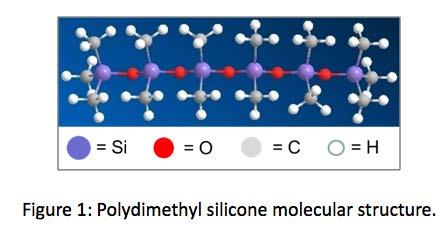
13 minute read
Advances in Silicone Copolymer Based Lubricants
ADVANCES
in Silicone Copolymer Based Lubricants
Chad Chichester & Christian Kranenberg Dow Corning Corporation
Introduction
One of the lubrication challenges today is the need for cost effective compromise between high temperature performance and lubricity performance like wear and friction reduction. Silicones, commonly known for their extreme temperature performance, as are other synthetic technologies like perfluoropolyether, and polyolester often trade off performance at high temperature for improved lubricity and vice versa. The following paper begins with a brief primer on siloxane based lubricants as an introduction to newly developed fluorosiloxane/phenylmethylsiloxane copolymers. Fluoro/ phenyl siloxanes are built on the thermal and oxidative stability of siloxane backbone molecules, functionalized with phenyl pendant groups for great thermal stability, and fluorinated pendant groups for improved wear and friction performance. Neat fluids as well as additized fluids and formulated greases are described and performance levels will be shared in this paper. The copolymer concept brings about flexibility in high temperature, and wear and friction performance, with improved additive acceptance. Additionally, molecular structure modeling will enable design of copolymer fluids with varying degrees of polymerization, functional branch types and lengths to offer many viable lubricant application possibilities.
Siloxane Base Fluids
Silicon is the 14th element of the periodic table. Considered semi metallic, or metalloid silicon is widely used in the semiconductor and solar industries for its dielectric and photovoltaic properties. Silicon and oxygen bonds can be polymerized to form materials known as siloxanes. Siloxanes can be functionalized with hydrocarbon-based pendent groups, or branches to make a category of materials known as silicones. Figure 1 is a depiction of the
molecular structure of one type of silicone, known as polydimethyl silicone. Different silicones with different functional groups exist for many types of applications, including silicone-based lubricants.
Siloxanes backbone molecular structures are characterized as having very strong bonds. The Silicon-Oxygen bond requires 460 kJ/mol to break as compared to Carbon-Carbon bonds, which break at 348 kJ/mol. This gives the backbone structure very high thermal stability. In addition, long bond lengths (0.164 nm) and high bond angles allow siloxanes to be extremely flexible and have low steric hindrance. Leading to low monomeric friction. Strong, flexible bonds, and low monomeric friction lead to good permanent shear stability. Siloxane backbones are already fully oxidized. This gives siloxanes great oxidative stability and low volatility. Siloxane chemistry, rooted in silicon instead of carbon, offer great chemical incompatibility, which allows utility with many plastics, elastomers, and chemicals, and generally, siloxanes are hydrophobic.
Today, many siloxane-based fluids used as lubricants fall into 3 primary categories. The molecular structure of these silicones can be seen in Figure 2. Dimethyl silicones are the most common. Made of siloxanes with methyl functional groups these silicones are typically filled with silica to be
used as static lubricants on elastomers and plastics, however, dimethyl silicones are poor metal-to-metal lubricants. Phenylmethyl silicones feature phenyl functional groups and have wider temperature ranges and improved metal-to-metal
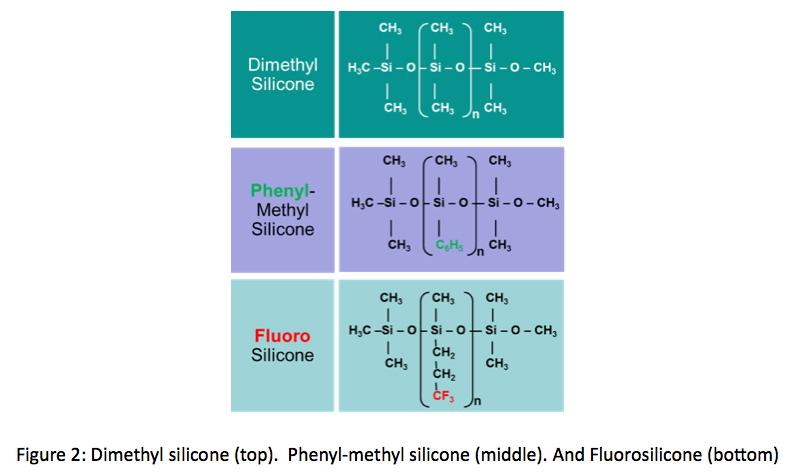
lubricity compared to dimethyl silicones. Fluoro silicones employ fluoro functional groups for even better metal-to-metal lubricity and have excellent chemical resistance, but these features come at the expense of a slightly reduced temperature range compared to phenyl silicones.
Phenyl-Fluoro Copolymers
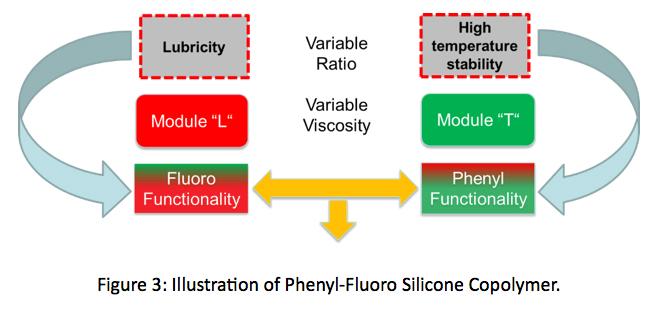
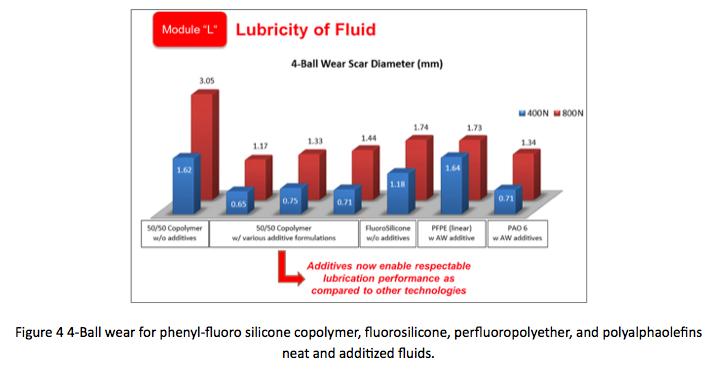
Imagine combining lubricity of fluoro silicones with thermal stability of a phenyl silicones all within the same molecular structure? This is the essence of fluoro/phenyl silicone lubricants, and is illustrated in Figure 3.. These copolymers can be made having varied ratios of phenyl to fluoro content to design base fluids for either higher lubricity or higher thermal stability. Like existing siloxanes many
viscosities can be produced. So far, copolymers with phenylfluoro ratios of; 25:75, 50:50, and 75:25 have been synthesized. Phenyl-fluoro ratios of 50:50 have been made with viscosities ranging from 400 to 5000 cSt.
Copolymer Lubricity
Examining lubricity aspects of silicone copolymers, Figure 4 graphically compares phenyl-fluoro silicone copolymer, fluorosilicone, perfluoropolyether, and polyalphaolefins neat and additized fluids. Silicone copolymers alone, while better than dimethyl silicones still do not perform as well in 4-ball wear testing as compared to other lubricant technologies. However, with additives silicone copolymers rival even additized PAO’s showing excellent promise for the use of additives in silicone fluids intended for lubricant materials. as lubricants, fluids of 100% phenyl silicone show large wear scars; hence, phenyl silicones are seldom used in metal-tometal contacts, except at low temperatures. On the other hand, fluorosilicones have better lubricity properties. When considering copolymers made of phenyl and fluoro functional groups, copolymers with higher fluoro content exhibit lower 4-ball wear scars than copolymers with lesser fluoro functional groups. One would expect wear resistance to be proportionate to the percentage of fluoro content. This is highlighted in Table 1. Interestingly, neat copolymer fluids with 25% phenyl content have lower 4-Ball wear scars than even 100% fluorosilicone fluid. This contradicts the hypothesis and is being explored; however, it will not be further discussed in this paper.
In addition, SRV testing (T = 50C, Freq = 50 Hz, Load = 300N, Stroke = 2 mm) was conducted on three ratios of phenyl/fluoro silicone copolymer as well as 100% fluorosilicone. In this case shown in Figure 5, coefficient of friction values reduce as the percentage of fluoro content increases. Supporting the idea that increased fluoro content will improve lubricity.
Broadening comparison, Table 2 shows phenyl/fluoro silicone neat fluid wear scar performance relative to other exiting base fluid technologies. The 25% phenyl/75% fluoro was nearly the best performing with a wear scar of 0.55 mm, second only to poly-glycol at 0.53mm.
Additive acceptance is another exciting property of

new phenyl/fluoro siloxane copolymers. Various wear improvement additives were added to 50:50 copolymers. Wear scars of neat fluid were compared to additized copolymers. Results are shown, graphically in Figure 6.
Wear scar reduction was observed by additizing 50:50 phenyl/fluoro silicone copolymer. At 400 N loads the highest response was obtained by using zinc diamyldithiocarbamate (2.5% treat rate), resulting in a 71% reduction in wear scar. Conversely, amin alkylisooctylphosphate additive (1.0%) showed no wear scar improvement. At 400 N loads the average wear scar improvement through additization (withholding 0% response of amin alkylisooctylphosphate ) was 53%. Looking at 800 N load conditions, three additives; antimony o,o-dialkylphoshorodithionate, dithiocarbamate, and zinc dialkyldithiophosphate yield a 59% reduction in wear scar. Interestingly, amin alkylisooctylphosphate, which had no impact at 400 N loads, yielded 33% reduction in wear scar. The average response of additives at 800 N was 46%. This data indicates that phenyl/fluoro silicone copolymers exhibit good wear additive response.
In summary of newly synthesized phenylmethyl/ fluoro siloxane copolymer lubricity. Higher fluoro content generally offers improved wear resistance and low frictional coefficient to other silicones and other synthetics. Soluble additives in these copolymers improve wear scar values, on average 50%. This enables phenyl/fluoro copolymers to be viable lubricants.
Copolymer Thermal Stability
Considering high temperature aspects of phenyl/ fluoro silicone copolymers. Silicones are known to have high viscosity indices (VI). Dimethyl silicones may have VI’s that reach as high as 400; however they may not always be applicable as a lubricant in many applications due to poor lubricity. Phenyl silicones will have VI’s around 220 and have better lubricity than dimethyl, but for metal-tometal contacts phenyls may still be lacking. Fluoro silicones have VI’s around 240, and much better lubricity than Phenyls. Phenyl/Fluoro copolymers, as expected have VI’s that range between 220 and 240, depending on the ratio of phenyl to fluoro functional groups.
Higher phenyl content yields VI’s closer to 220, while higher fluoro content produces VI’s closer to 240.
Thermographic Analysis (TGA) was performed from 30°C to 500°C. Exposure temperature begins at 30°C and increases 10°C per minute. At 250°C approximately 99% of copolymer material remained. This is nearly the same as phenyl silicone and linear PFPE, and surpasses the performance of PAO, POE, Fluorosilicone, and branched PFPE.
Differential Scanning Calorimetry (DSC) was used to identify Onset Oxidation Temperature (OOT) of phenyl/fluoro silicone copolymers, as well as other common synthetic fluids. Phenyl silicones have the highest OOT, over 360°C, and Fluorosilicone has an OOT of about 250°C. Copolymers examined vary in OOT between 250°C and 360°C depending on the amount of phenyl content. Copolymers with higher phenyl content had higher OOT than copolymers with higher fluoro content. This consistent with what was expected given the high thermal stability of phenyl silicone.
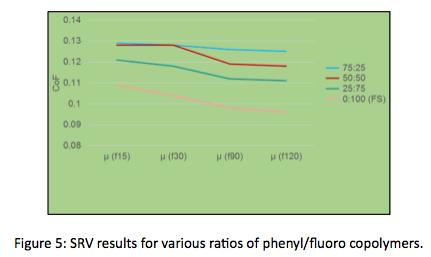
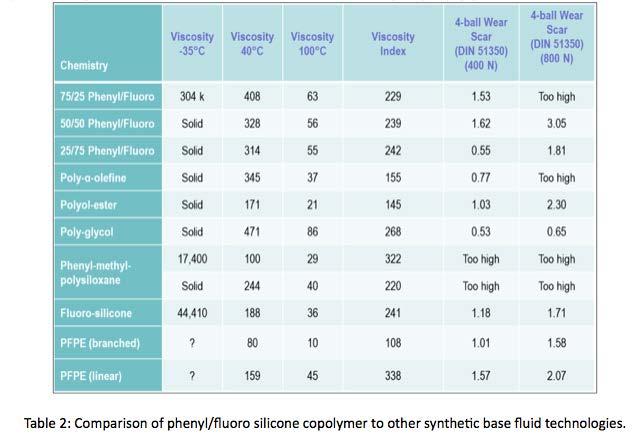
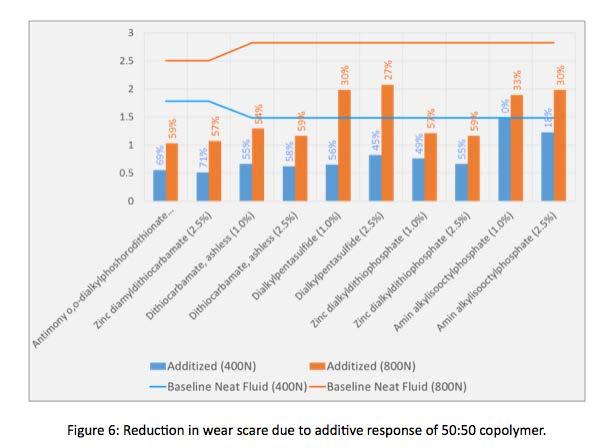
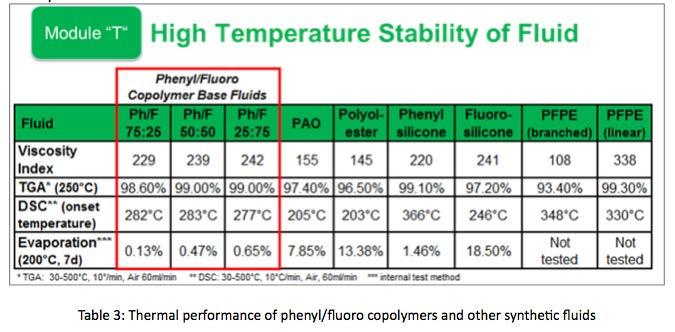
evaporation rates for all three ratios of phenyl/fluoro copolymers as compared to PAO, POE, and even pure phenyl and fluoro silicones. Phenyl/fluoro copolymer thermal performance is shown in Table 3.
Table 4 is a more complete summary of thermal and oxidative stability data generated, comparing phenyl/fluoro silicone copolymers to other common synthetic lubricants. In addition to TGA and DSC, phenyl/ fluoro copolymer thermo-viscous stability was evaluated. Samples of , 25:75, 50:50, and 75:25 phenyl/fluoro ratio copolymers were exposed to 250°C environment. Samples were cooled to 40°C and viscosity measured; then, re-heated to 250°C, held for 24 hours and viscosity re-measured. This process was repeated for several consecutive days. In open cup conditions viscosity began increasing after about 21 days, 28 days, and 42 days for the 25:75, 50:50, 75:25 phenyl/fluoro ratios, respectively. The rate change of 75:25 ratio was less steep than 25:75 and 50:50 ratios. This indicates better thermoviscous stability of copolymer containing higher phenyl content, as compared to other ratios. In closed cup conditions, viscosity decreases over time in a more linear fashion, with less change, again in the 75:25 copolymer. Both of these data illustrate better thermo-viscous stability in higher phenylated copolymer.
To summarize the thermal performance of phenyl/fluoro silicone copolymers, phenyl functional groups contribute greatly to the thermal performance of the copolymers. Copolymers with higher phenyl content have viscosity indices consistent with other silicone lubricants, and higher onset oxidation temperatures, with less evaporative weight
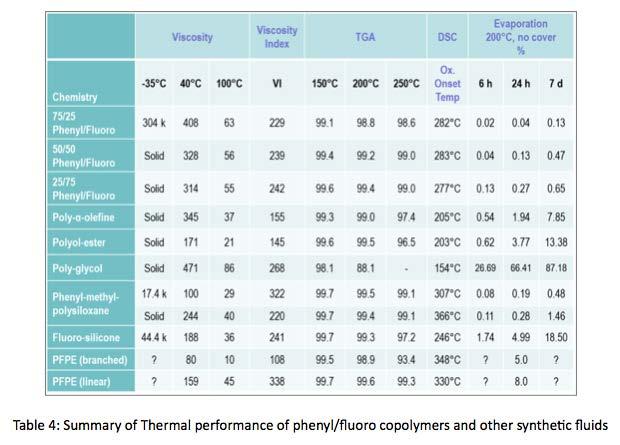
Phenyl-Fluoro Copolymer-Based Greases
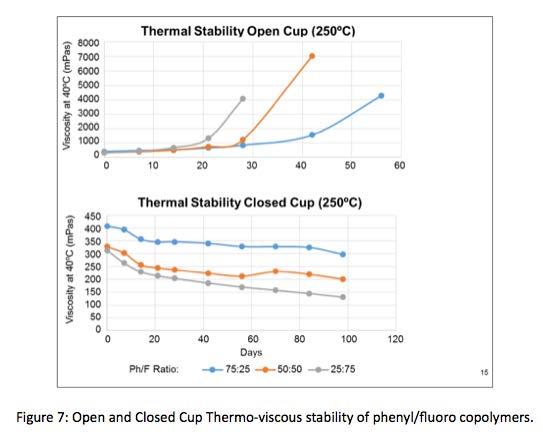
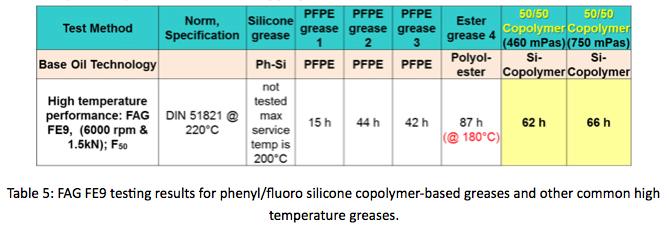
PTFE-thickened greases were formulated using phenyl/fluoro copolymer fluids of 460 mPa-s (390 cSt) and 750 mPa-s (640 cSt) viscosities. Greases were evaluated using standard grease tests. Specifically FAG FE9 testing was selected to examine high speed, high temperature performance. FAG FE9 is a lubricant rolling element bearing test. Spindle rotates at 6,000 rpm under axial load of 1500 Newtons. The test concludes when bearing torque increases due to lubricant failure. This test was modified to run at 220°C to push the temperature limits of the phenyl/fluoro copolymer grease. Copolymer-based greases, and other types of greases often used in high temperature applications were evaluated. Results shown in Table 5. Indicate copolymer greases performed well. Logging over 60 hours until failure.
SKF EMCOR Corrosion testing, shown in Table 6, was conducted on phenyl/fluoro silicone copolymer, Perfluoropolyether, pure phenyl silicone and Polyolester greases, to evaluate corrosion resistance. There was little evidence of corrosion in the EMCOR test, scoring a “0” on the EMCOR scale, indicative of little or no corrosion.
Another feature of phenyl/fluoro copolymerbased greases that may have utility is lower density compared to other high temperature greases. The density of copolymer greases is around 1.4 grams per cubic centimeter.


Shown in Table 7, this is about 30% lower in density than Perfluoropolyether-based greases.
Additional grease properties comparisons like penetration, dropping point, bleed & evaporation, etc.. of phenyl/ fluoro copolymer greases and other grease technologies can be seen in Table 8. It is good to point out that the copolymer greases are only base oil and PTFE thickener, with no additional additives.
Additionally, a lithium complex-thickened phenyl/ fluoro copolymer grease was produced. Notable changes in performance, seen in Table 9 of the lithium complex thickened copolymer grease to the PTFE thickened copolymer grease are reduction in bleed. Previously discussed phenyl/fluoro copolymer grease, thickened with PTFE had bleed rates over 4% compared to 0.46% bleed rate for lithium-thickened copolymer.
Future Siloxane Copolymer Development
Recall, paper 1505 from NLGI’s 82nd Annual Meeting titled, “High Temperature Grease Utilizing New Silicone Based Fluids”, by Dr. Manfred Jungk. Summarized in Figure 8 Paper 1505 discussed techniques developed by Dow Corning Corporation in collaboration with Northwestern University, to model tribological performance of silicone based lubricating fluids through understanding rheological impacts of molecular structure.
Future work to be done includes extending molecular structure modeling techniques for silicone lubricants to include phenyl/fluoro copolymer fluids. By adding
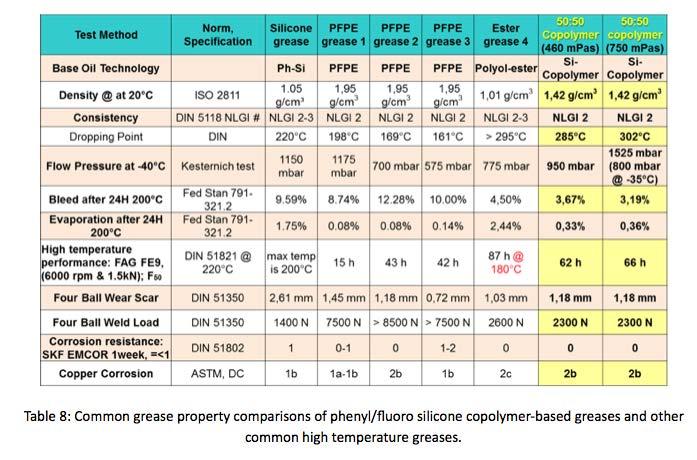
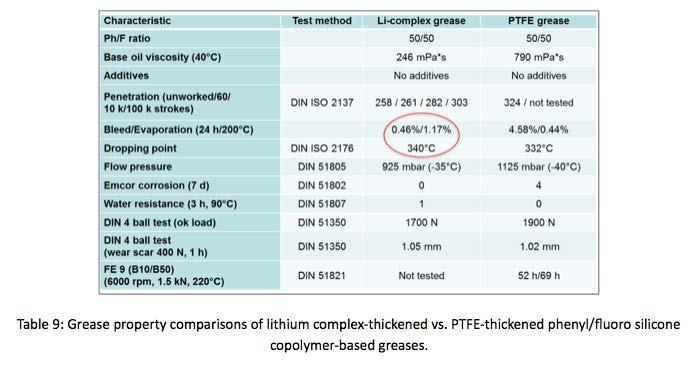
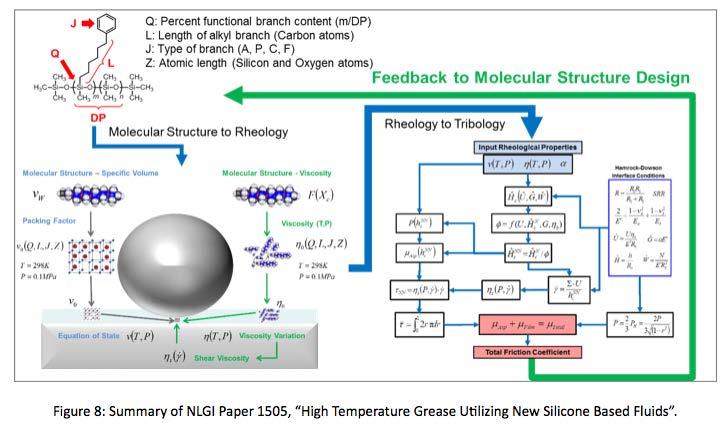
the phenyl/fluoro copolymer branch type to the molecular modeling toolbox. One could model tribological performance of phenyl/fluoro copolymers of many different phenyl-to-fluoro ratios, at varying degrees of polymerization, which allows for many viscosity evaluations to be done at the modeling stage of product development.
Summary
In Summary, phenyl/fluoro silicone copolymers, inherently retain exceptional thermal stability, oxidative stability, and high viscosity indices, for which silicone lubricants are known. Phenyl functional groups bonded to the siloxane backbone foster excellent high temperature properties, while flouro functional groups bonded to the same backbone contribute to better lubricity through improved wear resistance and friction reduction. Varying the phenyl to fluoro ratio one can also vary the thermal and lubricity performance. More phenyl and fewer fluoro groups yield higher thermal stability, while higher fluoro content and lower phenyl content yields better lubricity. Additive acceptance of phenyl/fluoro copolymers produce on average a 50% reduction in wear scar perfoamnce as compared to neat fluids. These phenyl/fluoro copolymers can be used as lubricating fluids, or used as base fluids for grease formulations. In additon, the use of molecualr modeling techniquies enable tribological modeling of many siloxanes to target key molecular structure variables with tribological performance in mind. Offering a wide range of viscosities, fucntional groups,and branch lengths these materialscan be designed with specific application performance in mind.
References
1. Zolper, T.J., Li, Z., Chen, C., Jungk, M., Marks, T.J., Chung, Y.-W., Wang, Q.:
Lubrication properties of poly-alpha-olefin and polysiloxane lubricants: molecular structure-tribology relationships. Tribol. Lett. 48, 355–365 (2012) 2. Zolper, T.J., Li, Z., Jungk, M., Stammer, A., Stoegbauer, H.,Marks, T.J., Chung,
Y.-W., Wang, Q.: Traction characteristics of siloxanes with aryl and cyclohexyl branches. Tribol. Lett 49, 301–311 (2013) 3. Zolper, T.J., Seyam, A.M., Chen, C., Jungk, M., Stammer, A., Stoegbauer, H.,
Marks, T.J., Chung, Y.-W., Wang, Q.: Energy efficient siloxane lubricants utilizing temporary shear-thinning. Tribol. Lett. 49, 525–538 (2013) 4. Zolper, T.J., Seyam, A.M., Chen C., Jungk, M., Stammer, A., Chung, Y.-W., Wang,
Q.: Friction and Wear Protection Performance of Synthetic Siloxane Lubricants.
Tribol. Lett. 51, 365–376 (2013) 5. Zolper, T.J., Jungk, M., Marks, T.J., Chung, Y.-W., Wang, Q.: Modeling polysiloxane volume and viscosity variations with molecular structure and thermodynamic state.
Journal of Tribology 136(1), 011801/1-011801/12 (2014). 6. Nevskaya, A., Jungk, M., Kranenberg, C., Weber, V.: Silicone base fluids for high temperature lubricants. EUROGREASE 3, 15-23 (2014).
Industry Calendar of Events
Please contact Kim if there are meetings/conventions you’d like to add to our Industry Calendar. kim@nlgi.org (Your company does not have to be an NLGI member to post calendar items.)
October 10 – 14, 2017 CLGI Biannual National Conference China Location and more information to come
October 14-17, 2017 ILMA Annual Meeting Hyatt Regency Grand Cypress Orlando, FL
October 31 – November 2, 2017 2017 Chem Show The Event for Processing Technology Javits Center New York City, New York www.chemshow.com
April 19-21, 2018 ILMA Management Forum Fort Lauderdale Marriott Harbor Beach Resort & Spa Fort Lauderdale, FL June 9 – 12, 2018 NLGI 85th Annual Meeting The Coeur d’Alene Resort Coeur d’Alene, ID
October 6-9, 2018 ILMA Annual Meeting JW Marriott Desert Springs Resort & Spa Palm Desert, CA
June 8 – 11, 2019 NLGI 86th Annual Meeting JW Marriott Las Vegas Resort Las Vegas, NV




